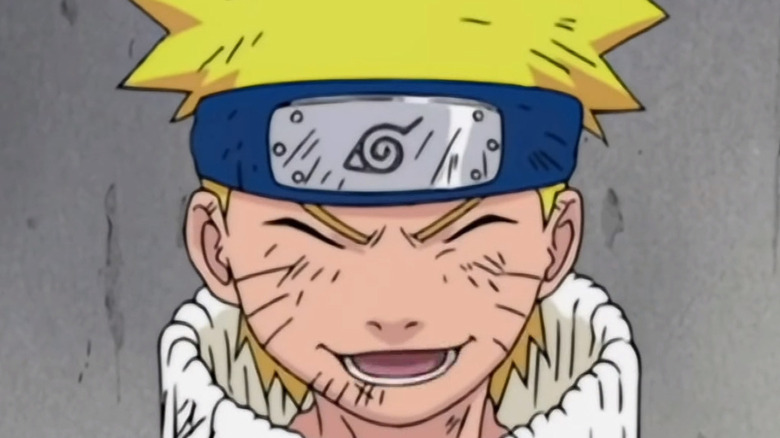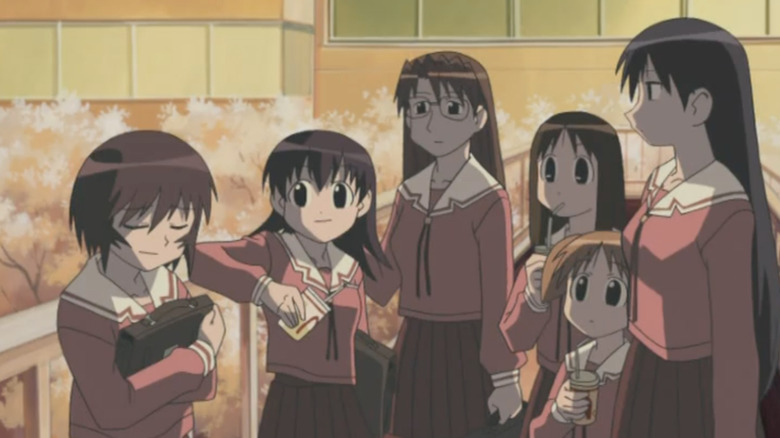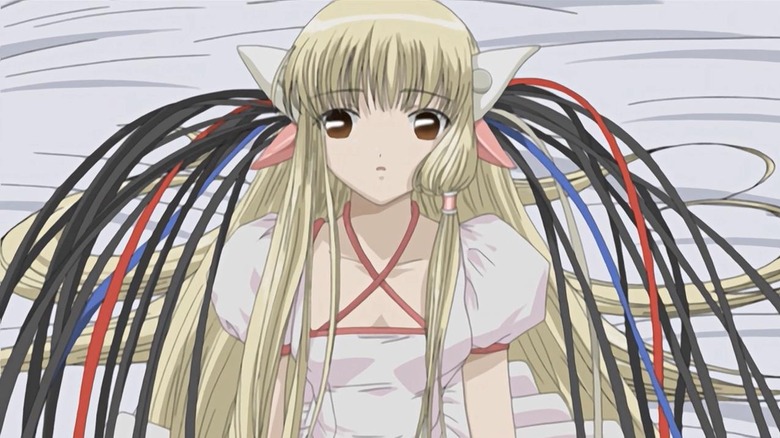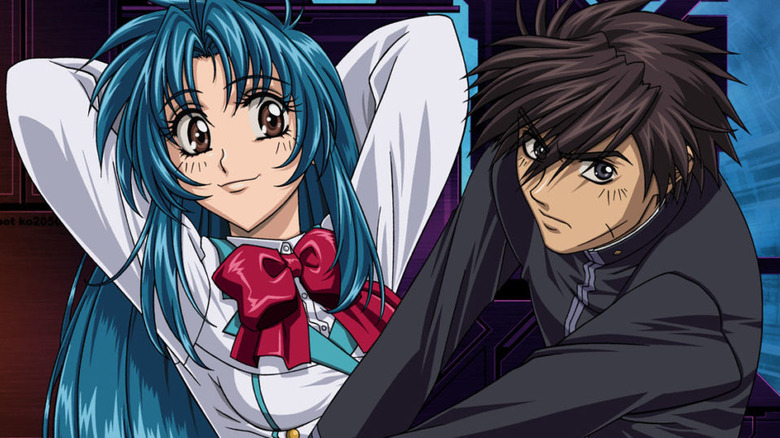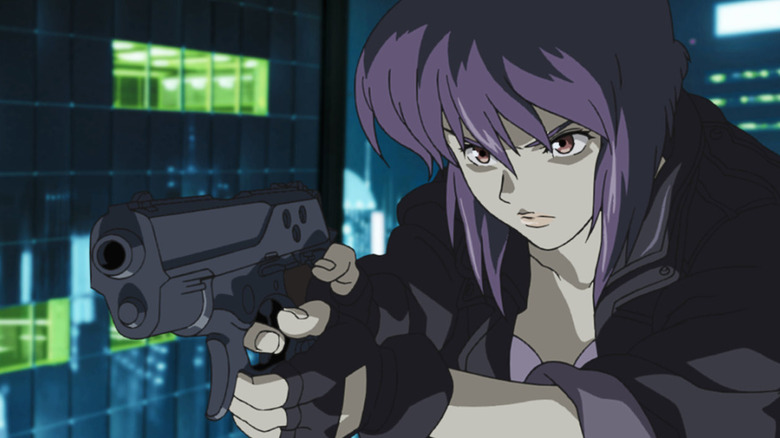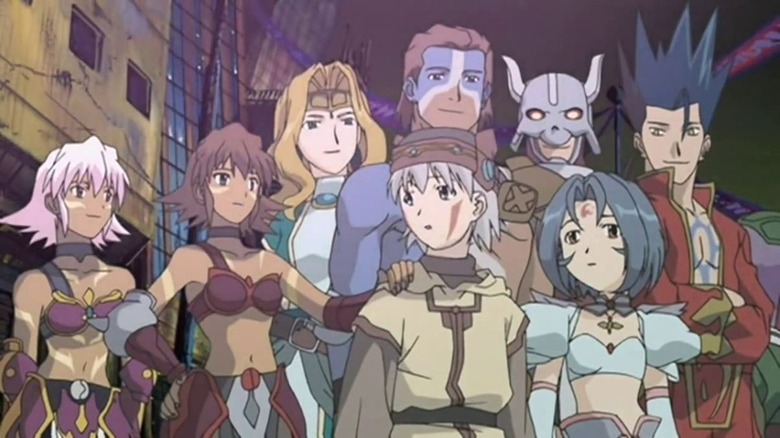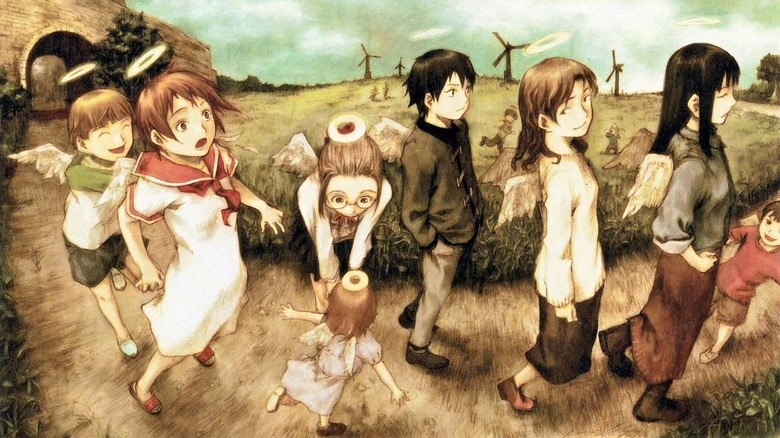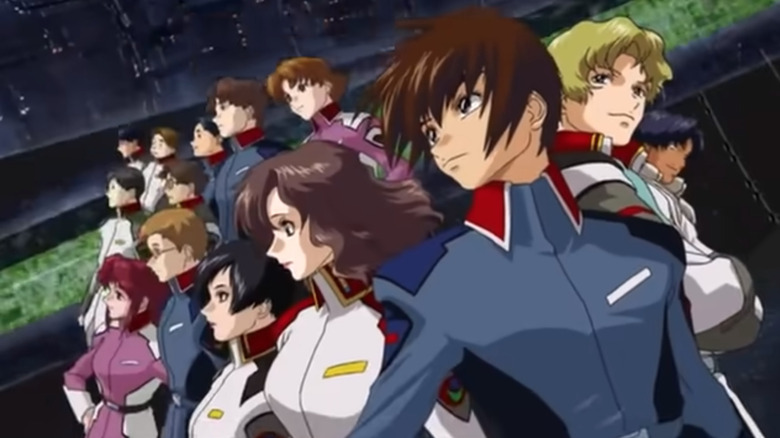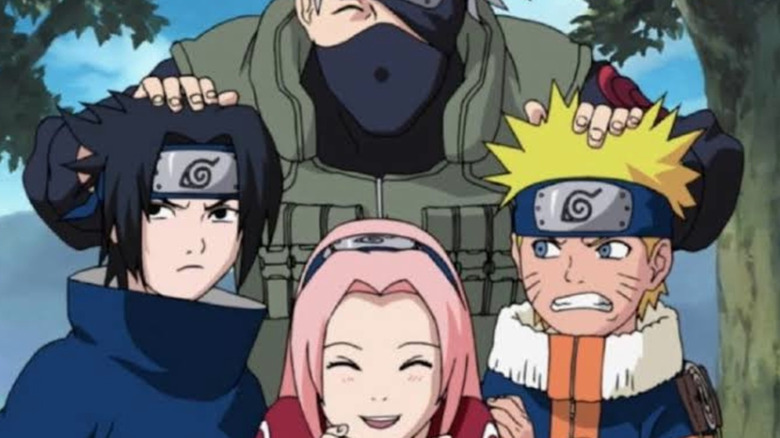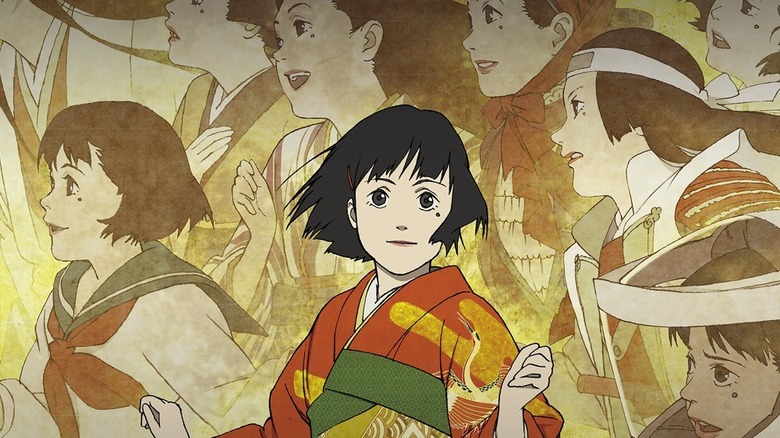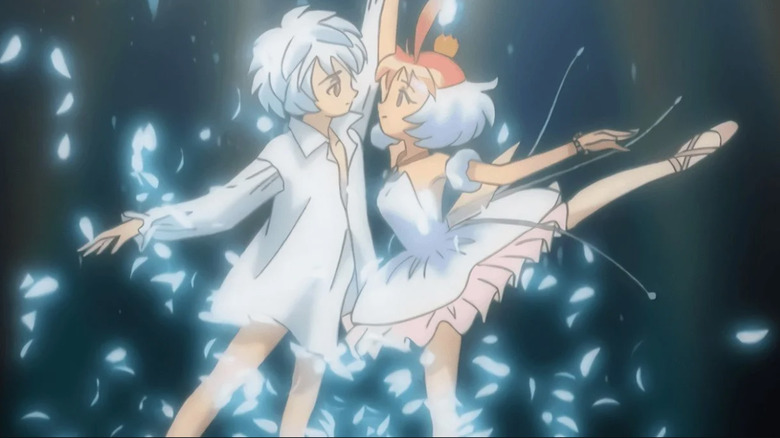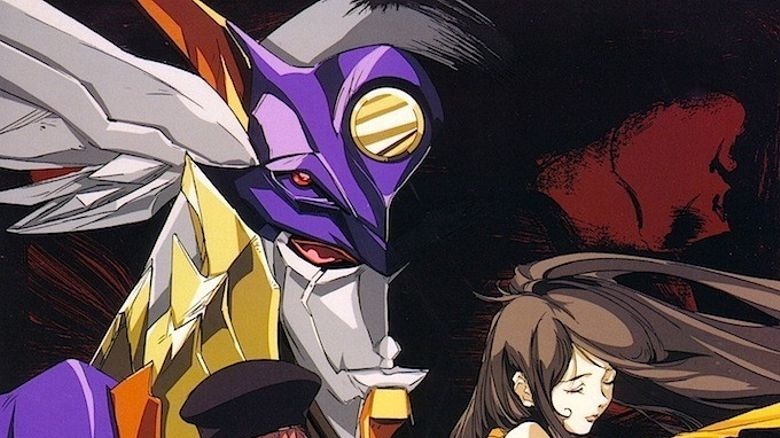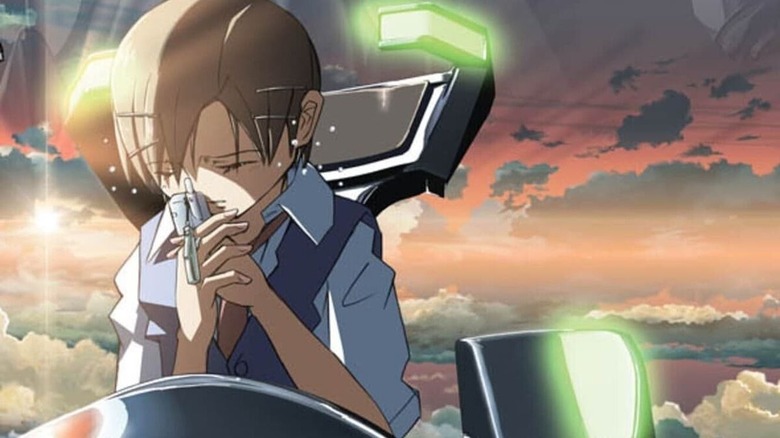Fan-Favorite Anime Turning 20 In 2022
According to the seasonal charts on MyAnimeList, 76 new anime series premiered on Japanese television in 2002. Twenty years later, the number of anime in production has only skyrocketed. Notably, the Winter 2022 season alone counts 41 new series, which is over half the total of the industry's yearly output just two decades earlier. 2002 was a big year for anime fandom in the United States, with the launch of Adult Swim's Saturday night anime block and the American release of Hayao Miyazaki's "Spirited Away," which would go on to win the Oscar. Anime was booming at the turn of the millennium, and we can credit breakthroughs in the early 2000s as paving the way for the mainstreaming of the art form in the early 2020s.
With that said, much of the anime class of 2002 has been forgotten years later. You're unlikely to find many nostalgic retrospectives on, say, "Galaxy Angel Z" or "Strange Steel Fairy Rouran." The best and brightest of the year's anime, however, are well-remembered by fans as classics. If you missed out on any of these gems, here's your chance to brush up on the fan-favorite anime turning 20 years old in 2022.
Azumanga Daioh
Before there was "Nichijou" and "Komi Can't Communicate," there was "Azumanga Daioh." Based on the four-panel gag manga by Kiyohiko Azuma, "Azumanga Daioh" is still one of the gold standards for slice-of-life comedy anime about high school girls being ridiculous. With little in the way of any ongoing plot, this episodic series is driven by the strong personalities of its eccentric cast of characters. From the pigtailed prodigy Chiyo-chan to the scatterbrained Osaka to the quiet and cat-obsessed Sakaki, there are no bad options when choosing your favorite among the main girls.
The best frenemy teachers, Yukari and Nyamo, are just as amusing their students, though your mileage may vary on their absurdly creepy co-worker Mr. Kimura, the one aspect of the show that keeps it from being truly family-friendly. Still, the show was successful in balancing the mundanity of the day-to-day school adventures with random humor and flights of fantasy (who can forget the giant alien cat who might be Chiyo's dad?).
Chobits
The all-female manga collective CLAMP is well-established as including some of the most influential authors in the world of shojo manga. "Chobits," published in Young Jump from 2000 to 2002, was CLAMP's first-ever seinen manga. A science-fiction romantic comedy for an adult male audience, "Chobits" shares the elegant style of CLAMP's shojo work but goes significantly more sexually explicit. The anime adaptation was released in 2002, written simultaneously with the final chapters of the manga.
Set in a world where anthropomorphic persocom androids serve as people's computers, "Chobits" follows the relationship between the human Hideki and his persocom Chi. Although Chi starts the series only able to say her name, she is actually one of the rare "Chobit" androids capable of free will and emotion. Still, there's a lot to unpack in the story's treatment of sexuality, and some have criticized the anime for glossing over the deeper themes in favor of Chi fan service.
Full Metal Panic!
Gonzo's "Full Metal Panic!" anime was originally set to air during the Fall 2001 season but was delayed to 2002 in response to the terrorist attacks on September 11. The show — based on light novel series written by Shoji Gatoh and illustrated by Shiki Douji — follows Sousuke Sagara, a tough-as-nails but socially inept agent from the military task force Mithril who must protect a high school girl Kaname Chidori from terrorist threats. Given the subject matter, it's understandable why the networks were sensitive about it in the aftermath of 9/11.
When it finally did premiere, the first "Full Metal Panic!" anime was well-received for its mix of mecha action and romantic comedy, and the comedic aspects of the franchise were heightened in Kyoto Animation's 2003 spinoff series "Full Metal Panic? Fumoffu." The mainline story received animated continuations in the form of 2005's "Full Metal Panic! The Second Raid" (also from Kyoto Animation) and 2018's "Full Metal Panic! Invisible Victory" (from Xebec).
Ghost in the Shell: Stand Alone Complex
Based on Masamune Shirow's classic 1989 "Ghost in the Shell" manga (which also inspired Mamoru Oshii's 1995 movie of the same name), "Ghost in the Shell: Stand Alone Complex" follows Motoko Kusanagi and her Section 9 anti-terrorism task force in a cyberpunk future where most people are at least partially cybernetic. The 26-episode 1st season contains both "stand-alone" episodic stories and an ongoing "complex" narrative about The Laughing Man, a cyber-terrorist whose story is an example of the sociological phenomenon known as a "stand-alone complex."
Writer-director Kenji Kamiyama's adaptation differs from Oshii's films by capturing more of the pulpy and comical aspects of the original manga, such as the adorable Tachikoma robots. Nevertheless, the TV series still engages in heavy philosophical discussions about what it means to be human. The series aired on Adult Swim in the United States in 2003, and "Stand Alone Complex" received a 2nd season in 2004 and a CGI Netflix follow-up in 2020.
.hack//SIGN
".hack//SIGN" was the start of the extensive ".hack//" multimedia franchise, which includes multiple video games, novels, anime, and manga, all centered around a futuristic MMORPG called "The World." The anime came out the same year as the first of Reki Kawahara's "Sword Art Online" web novels, so technically, both "trapped in a video game" isekai franchises were contemporaries of each other. However, "Sword Art Online" didn't receive an anime adaptation until a decade later.
"Sword Art Online" proved more influential overall in terms of the broader anime landscape, but some fans maintain that ".hack//SIGN" is the superior exploration of the same basic premise, emphasizing mystery and character development over action and fan service. Cartoon Network broadcast the show in the United States in 2003, and though the violence was mild enough to keep it off the Adult Swim block, its more mature themes led to it mostly airing it during late-night time slots.
Haibane Renmei
Yoshitoshi ABe is an artist most famous for doing character designs for the 1998 cyberpunk downer "Serial Experiments Lain." ABe was more heavily involved in the 13-episode anime "Haibane Renmei," adapting the screenplay from his own independently-published manga, which is as intellectually complex as "Lain" but provides a far more calming viewing experience.
The somewhat strange premise of this series centers around beings known as Haibane, who are born out of cocoons and look like humans with halos and wings (though they're not angels). They live in a walled city that they are not allowed to leave until they are no longer "sin-bound," at which point they can leave on their "Day of Flight." Living somewhat like monks, the Haibane do different jobs to help ordinary humans while following a strict set of rules. The slow-paced series is filled with symbolism and mysteries, which drive the various intense fan theories about what's actually happening.
Mobile Suit Gundam SEED
The 50-episode series "Mobile Suit Gundam SEED" was the first "Gundam" anime set in the Cosmic Era, one of many alternate timelines in the beloved mecha franchise. While the other alternate universe "Gundam" series diverge wildly in style and tone from the classic Universal Century "Gundam" stories, "Gundam SEED" sticks fairly close to its war drama template while making it more accessible for new viewers.
The main characters, Kira Yamato and Athrun Zala, are childhood friends and genetically-enhanced Coordinators forced to fight on opposite sides of the war between the Earth Alliance and the space-based ZAFT military organization. The bishounen cast helped "SEED" become extra popular with younger and female viewers, resulting in it becoming one of the most successful "Gundam" series in Japan. It received a sequel in 2004, "Mobile Suit Gundam SEED Destiny," and a high definition remaster in 2011. Response in America was more muted, and Anime News Network claims that it was the "last Gundam series to be aired on Cartoon Network, due to faltering ratings."
Naruto
Believe it! No other anime from 2002 remains as popular 20 years later as "Naruto" — even if it's now old enough for a whole new generation to think of its title character primarily as "Boruto's dad." Based on the hit "Weekly Shonen Jump" manga by Masashi Kishimoto, Naruto follows young outcast Naruto Uzumaki as he trains to become a ninja. He has high hopes of become the next Hokage, the leader of the Hidden Leaf Village, though his fellow villagers fear him because his body houses the Nine-Tailed Demon Fox that once destroyed the village.
The original "Naruto" anime ran for 220 episodes from 2002 to 2007. Many of the latter episodes were filler arcs that were produced so the manga wouldn't get ahead of the anime's storyline. It was followed up immediately in 2007 by "Naruto Shippuden," returning to the main story with the characters now two years older. "Shippuden" kept going for 500 episodes until reaching its conclusion in 2017. "Shippuden" was followed by "Boruto: Naruto Next Generations," which follows Naruto's son.
Millennium Actress
"Millennium Actress," the second feature film directed by the late great Satoshi Kon, made its world premiere at the 2001 Fantasia Film Festival in Montreal but wasn't officially released in Japan until 2002. This powerful drama follows aging actress Chiyoko as she recounts her life story of love and loss to a documentary team. What makes her story particularly interesting is how her memories mix up her personal experiences with the movies she's starred in, blending different genres and historical periods.
Chiyoko is based in part on the legendary Japanese movie stars Setsuko Hara and Hideaki Takemine (via Little White Lies), and "Millennium Actress" is filled with references to classic Japanese cinema, from Akira Kurosawa to "Godzilla." According to Heritage Auctions, it was one of the last major animated films to be produced on cels, and it beautifully handles its transitions between time periods. All this artistry comes together into a powerful dramatic tearjerker that demonstrates why Kon was one of the greatest directors in all of animation.
Princess Tutu
One of the best arguments for not judging an anime by its cover, "Princess Tutu" sounds absurd and looks like a cutesy children's show but is stealthily one of the best fantasy anime ever made. Created by Ikuko Ito and directed by Junichi Sato, both veterans of "Sailor Moon," this magical girl series is a creative work of metafiction set in a fairy tale world still under the control of its long-dead author.
The main character, Duck, is a duck who falls in love with a prince and takes a human form. Duck's also capable of transforming into Princess Tutu, who uses the power of ballet to solve people's problems and recover lost pieces of the prince's heart. A strange premise, to be sure, but the resulting story has surprising maturity and emotional depth. "Princess Tutu" offers ballet aficionados a lot to appreciate, with a great classical score and plot points taken from various beloved ballets.
RahXephon
"RahXephon" was one of the first major anime from Bones, the animation studio that went on to make "My Hero Academia" and both "Fullmetal Alchemist" series, among other hits. Like many mecha series from the late '90s and early 2000s, it's often compared to the influential "Neon Genesis Evangelion," though director Yutaka Izubuchi has said his biggest influence was actually the '70s mecha anime "Brave Raideen."
Similarities between "RahXephon" and "Evangelion" include enemies whose main genetic distinction from humanity is their blue blood and "robots" that aren't really robots but rather beings from Jewish mysticism (the Evangelions are angels trapped in mechanical shells, the Dolems in "RahXephon" are clay golems). While some viewers have called "RahXephon" a "rip-off" of "Evangelion," others consider it the superior anime due to its more active protagonist and cohesive storyline. Either way, there are no hard feelings between Izubuchi and "Evangelion" creator Hideaki Anno — the former went on to design the costumes for the latter's live-action "Cutey Honey" and "Shin Kamen Rider" movies.
Voices of a Distant Star
Fourteen years before "Your Name" broke records at the Japanese box office, Makoto Shinkai had already fully established his distinctive style as a director with the half-hour OVA "Voices of a Distant Star." Like almost every film Shinkai has touched since, "Voices of a Distant Star" is about lovers separated by a great distance — in this case, the vastness of space. Female lead Mikako is sent to fight in an intergalactic war, with only her cell phone to send messages to her boyfriend, Noburo. As the distance in light-years increases, communication takes longer and longer, with Noburo aging faster than Mikako due to the effects of relativity.
What made "Voices of a Distant Star" really stand out was the fact that Shinkai animated the entire film by himself on his PowerMac G4. Considering the technical limitations, the animation is downright incredible. Shinkai's subsequent films would grow more complex and employ more animators, but his intense hands-on touch remains a big part of his success.
